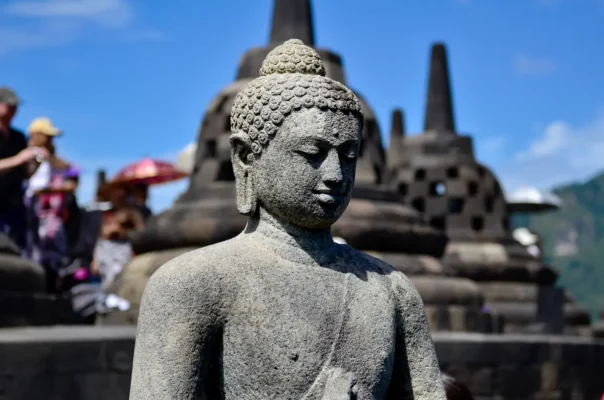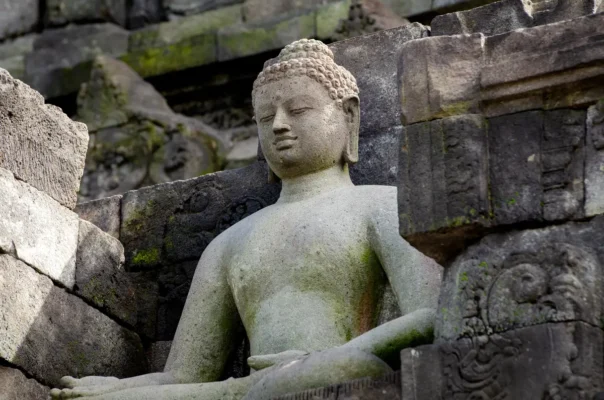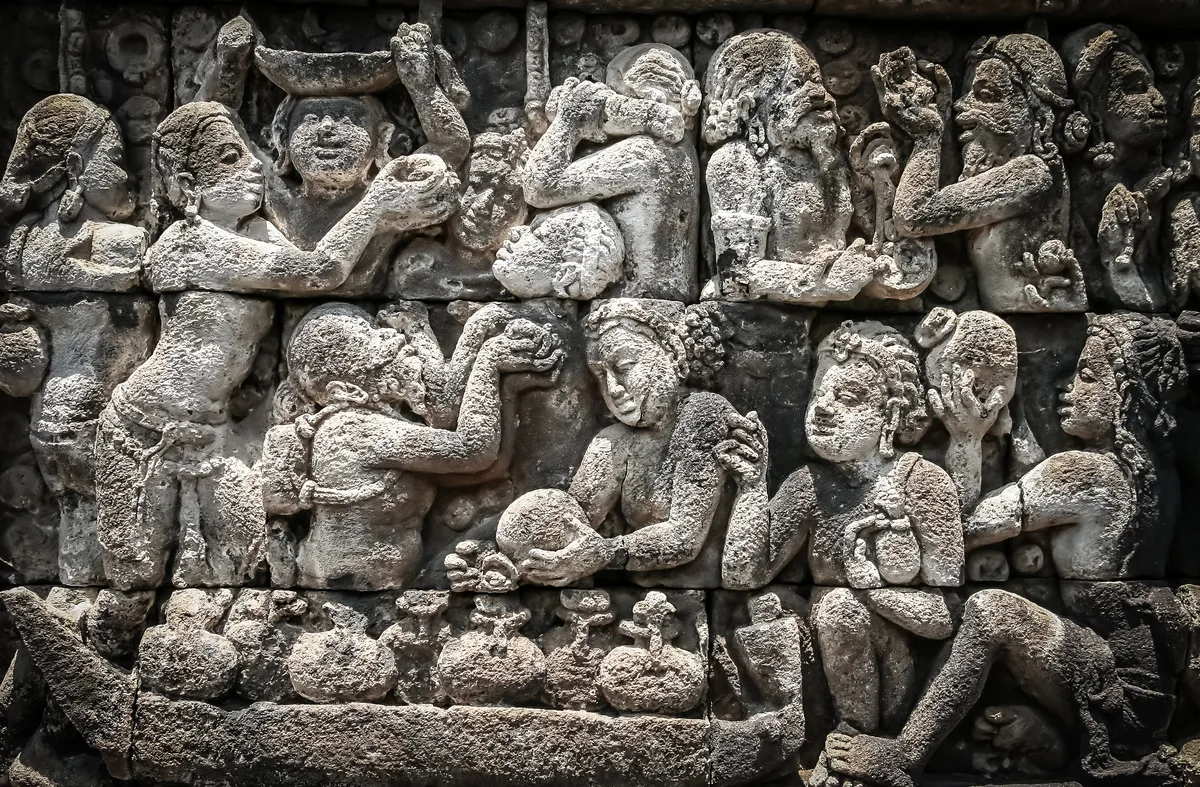Trevminusantara – Nestled in the lush heart of Central Java, Borobudur Temple stands as one of the most magnificent testaments to ancient spiritual architecture in the world. Built in the 8th century during the reign of the Sailendra Dynasty, this UNESCO World Heritage Site is more than just a historical monument it is a living symbol of Buddhist philosophy, etched in stone and structure.
As travelers approach the temple’s majestic form, they are not just witnessing ancient ruins they are stepping into a sacred narrative. Every stone, stupa, and relief panel holds layers of meaning, guiding visitors through a journey of reflection and enlightenment.
This deep spiritual narrative is what we call Borobudur Temple’s symbolism a profound embodiment of the Buddha’s path toward Nirvana, carefully crafted across the temple’s terraced design. Understanding the significance of Borobudur goes beyond admiring its massive scale or beautiful carvings.
It requires stepping into the ancient mindset that viewed the temple not only as a place of worship but also as a three-dimensional mandala a cosmic diagram representing the universe and the inner path to awakening. This is why exploring Borobudur history is both a cultural and personal pilgrimage.
The Structure of Borobudur: A Reflection of Buddhist Teachings

One of the most fascinating aspects of Borobudur Temple’s symbolism lies in its architectural design. From a distance, the temple resembles a giant stepped pyramid, but up close, it reveals itself as a spiritual map one that reflects the Buddhist cosmology and guides visitors on a symbolic path toward enlightenment.
Borobudur design is made up of three distinct levels: Kamadhatu, Rupadhatu, and Arupadhatu. These are not just physical layers they represent stages of consciousness in Buddhist teachings.
The base level, Kamadhatu, symbolizes the world of desires, where humans are trapped in worldly attachments. Climbing higher to Rupadhatu, visitors pass through beautifully carved galleries representing the world of forms an intermediate state of awareness.
Finally, at the top lies Arupadhatu, the realm beyond form, marked by serene, empty stupas that symbolize spiritual liberation. This tiered structure isn’t just a marvel of Borobudur architecture; it’s a narrative carved in stone.
The Symbolism of the Relief Panels: Visual Storytelling of Buddha’s Life
As you walk along the corridors of Borobudur, the stone walls come alive with stories. These intricate carvings known as Borobudur reliefs are more than just decoration.
They serve as a visual guide to Buddha’s life and his journey toward enlightenment, offering timeless lessons through art that speaks across cultures and centuries. Spanning over 2,600 individual panels, the reliefs depict scenes from the life of Siddhartha Gautama, from his royal upbringing to his renunciation of worldly pleasures, his deep meditation, and ultimately, his enlightenment journey.
These panels are arranged in a narrative sequence, inviting visitors to move slowly and reflectively, absorbing the teachings through each image. What makes these carvings truly special is how they reflect Buddhist symbolism in Borobudur.
They don’t merely retell stories they represent moral choices, spiritual trials, and philosophical insights. For instance, one panel may show the Prince leaving his palace, symbolizing the first step toward inner awakening.
The Stupas and Their Spiritual Significance

At the summit of Borobudur, a breathtaking sight awaits: dozens of bell-shaped structures known as Borobudur stupas, quietly standing against the sky. These are not just architectural ornaments they are powerful spiritual symbols that capture the essence of Buddhist philosophy and the temple’s deeper meaning.
In the context of Borobudur Temple’s symbolism, the stupas represent the final stage of the spiritual journey the attainment of Nirvana. As you ascend the upper terraces, the intricate reliefs disappear, replaced by silence and simplicity.
This transition is intentional. It mirrors the Buddhist idea that as one approaches enlightenment, the distractions of the material world begin to fade. Each stupa contains a statue of the Buddha seated in meditation, although the largest central stupa at the very top is completely empty.
This empty stupa is one of Borobudur’s most profound symbols. It reflects the concept of Śūnyatā, or emptiness, which in Buddhism represents the absence of ego and attachment a core condition for reaching Nirvana.
The placement and design of these Buddhist stupas are also aligned with sacred geometry, forming part of the temple’s grand mandala layout. The repetitive, harmonious structure encourages visitors to walk in meditative silence, engaging not just with the view, but with their own thoughts and inner peace.
The Mandala Design: Spiritual Geometry at Borobudur
One of the most captivating aspects of Borobudur Temple’s symbolism is its layout designed as a massive three-dimensional mandala, a sacred diagram in Buddhism representing the universe and the path to enlightenment. Viewed from above, Borobudur mandala design reveals a perfect square base with four stairways leading to a circular platform at the top.
This unique fusion of square and circle reflects the union of earthly life (the square) with spiritual transcendence (the circle). It’s not just beautiful it’s deeply meaningful.
This kind of spiritual geometry was intentional. Ancient architects and spiritual thinkers collaborated to build a structure that mirrored the cosmic order, symbolizing harmony between the microcosm (individual) and macrocosm (universe).
Walking through Borobudur is like moving through a living mandala you begin at the base, representing the world of desire, and slowly ascend toward the center, the symbol of spiritual awakening.
Each level of the temple aligns with a different state of consciousness, guiding visitors on a symbolic pilgrimage.
The Influence of the Temple’s Symbolism on Modern-Day Visitors
For many travelers, visiting Borobudur is more than a sightseeing stop it becomes a transformational experience. The quiet power of Borobudur Temple’s symbolism continues to resonate deeply with modern-day visitors, bridging ancient wisdom with personal reflection.
Today, spiritual tourism is growing worldwide, and Borobudur has emerged as a powerful destination for those seeking inner peace and meaning. As visitors walk through the temple’s ascending terraces, they often describe a sense of calm, clarity, and connection especially when engaging in meditation at Borobudur, surrounded by serene stupas and panoramic views of Java’s countryside.
What makes the Borobudur experience so unique is how the temple speaks without words. The structure, reliefs, and layout act as spiritual cues, inviting visitors to slow down and reconnect with their inner selves.
Whether you’re a Buddhist practitioner or simply a curious traveler, the journey through Borobudur mirrors a personal pilgrimage an inward journey that reflects the ancient Buddhist pilgrimage route the temple was originally built for. Many guests leave the site not just with beautiful photos, but with a renewed sense of perspective.
Why Choose Trevmi Nusantara for Your Borobudur Experience
To truly understand Borobudur Temple’s symbolism, it helps to explore the site with someone who knows its layers of meaning both historical and spiritual. That’s where Trevmi Nusantara comes in. As a trusted Borobudur travel agency, Trevmi Nusantara offers thoughtfully curated experiences that go far beyond the average temple visit.
Read: Borobudur Architecture Influences: Exploring its Legacy and Global Impact
With Trevmi Nusantara Borobudur tours, you’re not just walking through a temple you’re being guided through a story that spans centuries. Their expert local guides provide rich context about Buddhist philosophy, ancient rituals, and hidden details of the temple’s architecture and carvings.
Conclusion
Borobudur Temple’s symbolism offers more than just historical value it opens the door to a profound spiritual journey. From its mandala-inspired structure to the detailed reliefs of Buddha’s life, every aspect of this majestic monument invites visitors to reflect on the deeper truths of Buddhist philosophy.
It’s a place where architecture becomes wisdom, and where travel turns into transformation. For those seeking not just a tour, but a true Borobudur spirituality experience, the temple offers moments of silence, clarity, and inner connection.
Walking its sacred paths allows you to retrace the symbolic steps toward enlightenment, making each visit personal and meaningful. To fully immerse yourself in this spiritual heritage, guided Borobudur tours with cultural insight can make all the difference.


